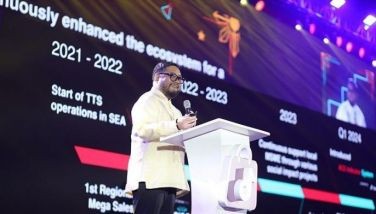UP experts identify emerging S&T fields
July 6, 2006 | 12:00am
In a world defined by rapid technological advancements and constant scientific breakthroughs, it is hard to predict what comes next. But looking at and understanding current trends in science and technology make it easier to gauge what may be. That’s exactly what scientists at the University of the Philippines (UP) did.
A committee tasked to identify important emerging S&T fields has named the following: materials; biotechnology or bioengineering; pervasive computing; and measurement and instrumentation, relative to the first three mentioned.
These are called emerging fields because they have evolved with the demands of the times or are offshoots of existing fields where knowledge is either inadequate or even non-existent.
Developing and strengthening academic initiatives in emerging S&T fields is part of UP President Emerlinda Roman’s agenda for the next five years.
She has asserted that UP will "continue to help the country build up its scientific manpower base which is crucial to progress and development."
As the national university in the 21st century, "UP should contribute by training students to further strengthen our country’s science capacity and by creating knowledge through research for domestic production and for public sector policy formulation and implementation," she said.
Chaired by vice president for academic affairs Dr. Amelia Guevara, the committee is composed of Dr. Victor Ella of UP Los Baños; Dr. Alvin Marcelo of UP Manila; and Dr. Joel Marciano, Dr. Caesar Saloma and Dr. Titos Quibuyen of UP Diliman.
Guevara emphasized that these cutting-edge S&T fields need to be advanced to the highest possible level of inquiry in order to generate new knowledge.
To show the government that UP’s S&T agenda coincides with and supports the National Science and Technology Plan 2002-2020, a presentation on these emerging fields was recently made to Science and Technology Secretary Estrella Alabastro, Undersecretary Graciano Yumul Jr. and the heads of the various agencies of the Department of Science and Technology.
The presentation was also an invitation to join forces with the department to intensify S&T in the country through various research projects.
On the field of materials, of which nanomaterials is a subfield, Quibuyen said UP has "very little experience and infrastructure in the areas of nanoscience and nanotechnology… but if UP cannot compete in terms of production, it should understand the field, interpret its meaning and consequences to the inquiring public and prepare the next generation of Filipinos to be more adaptive to a nanomaterial world."
Marcelo, meanwhile, declared that a better understanding of the life sciences through biotechnology or bioengineering "promises to revolutionize society and usher in the genomic century – heralded by the complete sequencing of the human genome."
According to Marciano, pervasive computing is a "strongly emerging trend toward the deployment and use of numerous, casually accessible, often invisible computing devices that are frequently mobile or embedded in the environment and connected to an increasingly ubiquitous network structure."
Lastly, Saloma, the new dean of the UP College of Science, explained that measurement and instrumentation is necessary in the pursuit of these academic initiatives in emerging S&T fields because "there is no science without measurement."
A committee tasked to identify important emerging S&T fields has named the following: materials; biotechnology or bioengineering; pervasive computing; and measurement and instrumentation, relative to the first three mentioned.
These are called emerging fields because they have evolved with the demands of the times or are offshoots of existing fields where knowledge is either inadequate or even non-existent.
Developing and strengthening academic initiatives in emerging S&T fields is part of UP President Emerlinda Roman’s agenda for the next five years.
She has asserted that UP will "continue to help the country build up its scientific manpower base which is crucial to progress and development."
As the national university in the 21st century, "UP should contribute by training students to further strengthen our country’s science capacity and by creating knowledge through research for domestic production and for public sector policy formulation and implementation," she said.
Chaired by vice president for academic affairs Dr. Amelia Guevara, the committee is composed of Dr. Victor Ella of UP Los Baños; Dr. Alvin Marcelo of UP Manila; and Dr. Joel Marciano, Dr. Caesar Saloma and Dr. Titos Quibuyen of UP Diliman.
Guevara emphasized that these cutting-edge S&T fields need to be advanced to the highest possible level of inquiry in order to generate new knowledge.
To show the government that UP’s S&T agenda coincides with and supports the National Science and Technology Plan 2002-2020, a presentation on these emerging fields was recently made to Science and Technology Secretary Estrella Alabastro, Undersecretary Graciano Yumul Jr. and the heads of the various agencies of the Department of Science and Technology.
The presentation was also an invitation to join forces with the department to intensify S&T in the country through various research projects.
On the field of materials, of which nanomaterials is a subfield, Quibuyen said UP has "very little experience and infrastructure in the areas of nanoscience and nanotechnology… but if UP cannot compete in terms of production, it should understand the field, interpret its meaning and consequences to the inquiring public and prepare the next generation of Filipinos to be more adaptive to a nanomaterial world."
Marcelo, meanwhile, declared that a better understanding of the life sciences through biotechnology or bioengineering "promises to revolutionize society and usher in the genomic century – heralded by the complete sequencing of the human genome."
According to Marciano, pervasive computing is a "strongly emerging trend toward the deployment and use of numerous, casually accessible, often invisible computing devices that are frequently mobile or embedded in the environment and connected to an increasingly ubiquitous network structure."
Lastly, Saloma, the new dean of the UP College of Science, explained that measurement and instrumentation is necessary in the pursuit of these academic initiatives in emerging S&T fields because "there is no science without measurement."
BrandSpace Articles
<
>
- Latest
Latest
Latest
February 24, 2024 - 10:30am
By Issam Ahmed | February 24, 2024 - 10:30am
February 8, 2024 - 8:45am
February 8, 2024 - 8:45am
January 29, 2024 - 1:22pm
January 29, 2024 - 1:22pm
January 26, 2024 - 11:13am
By Issam Ahmed | January 26, 2024 - 11:13am
January 25, 2024 - 4:37pm
By Kyoko Hasegawa | January 25, 2024 - 4:37pm
January 22, 2024 - 9:17am
January 22, 2024 - 9:17am
Recommended























